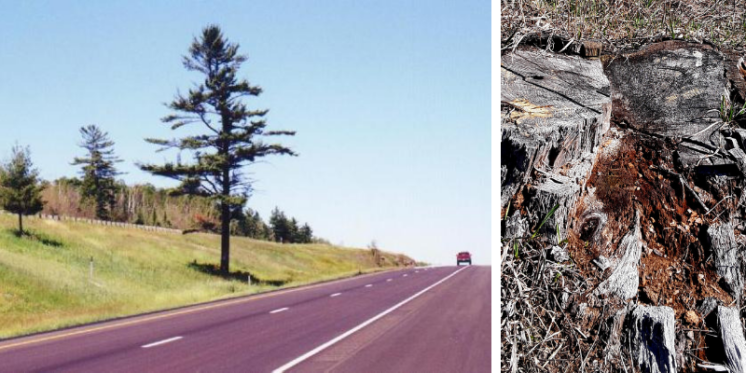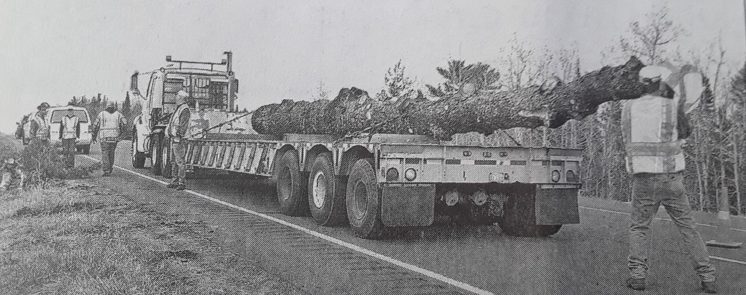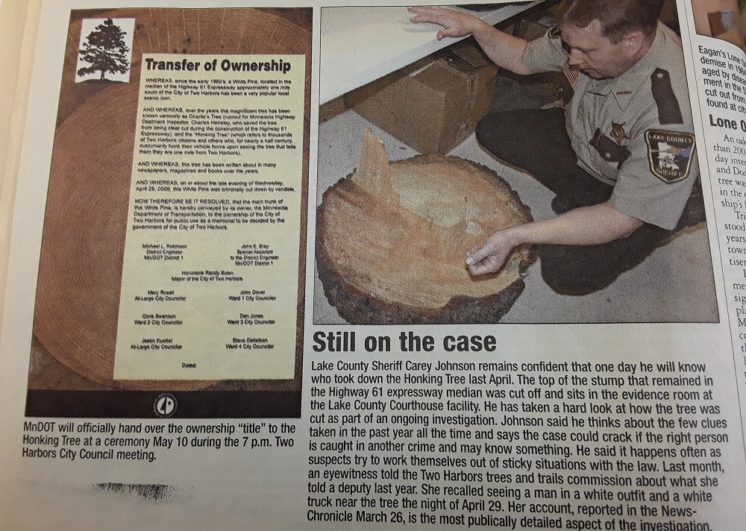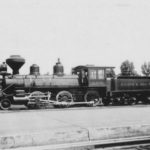Honking Tree case remains a mystery 10 years later

Left: July 2001 photo of the Honking Tree from the Two Harbors Forum website. Right: The modern remains of the Honking Tree stump between Larsmont Road and Isaacson Road southwest of Two Harbors. Photo by Mike Creger.
I asked Lake County Sheriff Carey Johnson this month if there was anything new in the now 10-year-old Honking Tree case.
“You mean the white pine murder investigation?” he said straightaway.
Gallows humor. For law enforcement officers, and journalists, the daily barrage of the bizarre and inexplicable often calls for a bit of bemused detachment.
I gave him a knowing laugh.
On the morning of April 30, 2009, the 107-year-old Honking Tree was found on the ground, presumably cut down overnight. All that day, as word spread, people migrated to the spot between the southbound and northbound lanes of the Highway 61 Expressway, about three miles southwest of Two Harbors between Larsmont Road and Isaacson Road.
Family lore has it that one would honk at the tree upon returning to the Two Harbors area from points south. The tree was saved from clearcutting for the expressway that had been under construction starting in 1959. The Minnesota Department of Transportation referred to the pine as “Charlie’s Tree,” for chief inspector Charlie Hensley, who insisted the tree be left unharmed in the highway median. He would often have lunch under the tree while on the project.
“People felt fond of that tree,” Sheriff Johnson told me.
The nature of a small town can often help law enforcement in solving crimes. People talk, and, after sorting through unhinged gossip and solid leads, a break can come.
But 10 years ago Johnson was fairly confident he might never know who cut down the Honking Tree. The incident was too hot, he told me a year after it happened. People were angry and he assumes even today that the perpetrator might feel the “death penalty” is a possiblity. “I still think if it hadn’t blown up we would have had something,” Johnson said.
Today his department is where it was 10 years ago. No one knows who cut the tree down. The portion of the stump showing how the cut was made remains in the sheriff’s office evidence room. Johnson, returning to that gallows humor, said he thought of presenting the stump portion to the retiring investigator who worked on the Honking Tree case. “I got a lot of mileage out of that,” he said.
There was an investigation and the case is still open. People who live in the area were canvassed, mostly to find out if they had seen anything, and, perhaps, to quell the many rumors that a neighbor of the tree had grown tired of the honking and cut it down. There remains a strong reticence to marking the spot of the Honking Tree, for fear that it will induce a return to the honking.
People were checked out. Johnson said there was a one-time suspect who later confronted deputies in a standoff. He was a bit off-center, Johnson said, but was dismissed as the tree cutter.
There were the obvious rumors that the cutting was some sort of high school prank, either with students from the Two Harbors area or a rival school. They were rumors only, difficult to keep at bay, Johnson said, but nothing to hang the case on.
An eyewitness came forward weeks after the felling to tell the sheriff’s office she recalled seeing a man wearing a white hardhat and white lab coat near the tree. He was holding a small chainsaw, she reported. There was also a white pickup, she said. She assumed the man was a “tree doctor.”
That information was a surprise at a public meeting in Two Harbors the next year when the woman announced what she told police. Johnson assured the public that her information had been taken in, but nothing came of it. Her story partly checked out, Johnson said, because the markings where the tree was cut indicated that a small saw was used. Johnson surmised at the time that whoever cut the tree didn’t get all the way through the trunk and it toppled in high winds the night before it was discovered on the ground.

The Honking Tree was loaded onto a trailer on April 30, 2009, after it was felled sometime the night before. The Minnesota Department of Transportation had ownership of the tree as it stood in the median of the Highway 61 Expressway a few miles southwest of Two Harbors. This photo is from MnDOT archives as it appeared in the Lake County News-Chronicle in April of 2010.
Memorial hits and misses
I became the editor of the Lake County News-Chronicle in Two Harbors in the fall of 2009. That next spring, I began work on a one-year commemoration of the Honking Tree incident. There was some small hope that returning to the time of the crime might dislodge a clue from someone into what happened.
But I found many people had moved on. While they still harbored strong feelings about losing the tree, there was a general shrugging of the shoulders about ever finding out who cut the tree down and a lot of handwringing about creating any symbolic legacy from the wood of the former Two Harbors landmark.
MnDOT had raised some money and had sections of the Honking Tree trunk cut to form large medallions that were laser-etched with a silhouette of the Honking Tree and a simple “1902-2009,” indicating the estimated birth and death of the tree. The medallions were presented to city and civic groups and a few businesses, including the News-Chronicle and the original Black Woods Grill & Bar, which uses an artistic depiction of the Honking Tree in its logo.
MnDOT had rights to the tree, but donated its remains to the city of Two Harbors. Smaller rounds were cut from branches of the tree and sold to raise money for a potential memorial. For reasons that remain unclear, those small rounds had “1879-2009” marked on them.
At one point in summer 2009 the Larsmont Community Club wanted the tree. It was a part of the community there, it reported in a newsletter. Marlys Welch was assigned to contact MnDOT and ask for the tree trunk and about creating a totem pole from it to place where the Honking Tree once stood. Welch said recently that she did follow up but the tree had already been turned over to Two Harbors.
Many had said in the year after the tree was cut down that people should move on. Others felt a memorial was important. There was, after all, a large tree involved and wood that now rested unused.
There was also the fear that wherever a memorial was placed, drivers would honk and it would become much more of a nuisance than honking on the four-lane expressway.
It was eventually decided, after some public discourse, that the Honking Tree would be carved into some sort of memorial. The first idea was to create a replica of Split Rock Lighthouse, the famed icon that sits 20 miles up the North Shore from the city. That caused an expected uproar. The Honking Tree was a Two Harbors icon, not a North Shore one, people said. If there was to be a lighthouse carved from the tree, it should be the one that sits off Agate Bay in the city.
Noted chainsaw sculptor John Gage said that wasn’t what he signed up for. Because the Two Harbors Light Station is square, he couldn’t simply carve its shape with the Honking Tree trunk.
But he said he’d give it a go by creating a framework replica of the lighthouse and then siding it with planed boards from the Honking Tree.
Those planed boards remain unused on Gage’s property outside of Two Harbors. He studied the lighthouse and made measurements for a scaled replica. He started work on the frame and got an estimate for including glass in the upper portion of the memorial. It all came with a cost, and he went to the entity in charge of the memorial, the Two Harbors Trees and Trails Commission to ask about funding.
“I was told they had $60,” Gage told me this month. “That’s the last I ever heard from anybody.”
John Dover was on the Trees and Trails Commission at the time and said he thought Gage had completed the project and it was turned over to the Public Arts Commission. No one from the arts commission, past or present, is aware of any Honking Tree project.
Dover said he doesn’t recall anything about funding for the memorial.
Gage should know. The boards have sat at his place for nearly a decade, unused. He said he’d be more than happy to start something up again. “The boards are here. If you hear anything, let me know.”
I asked current Two Harbors Mayor Chris Swanson about any news on the memorial. He was on the city council at the time the tree was felled. He wasn’t able to find out much at all.

Lake County Sheriff Carey Johnson appeared in this photo from the News-Chronicle in Two Harbors nearly a year after the Honking Tree was toppled in April 2009. This page from the paper also shows the official transfer of the tree from the Minnesota Department of Transportation to the City of Two Harbors.
Two Harbors, the enigma
Looking back, that fact that there is no memorial, despite the efforts of some to get one erected, is no surprise. Two Harbors has a long history of shouda-coulda-woulda projects. It’s a town divided by longstanding loyalties to the past and strong opinions about the future. While diverse discourse can have its place, it has often left the city spinning its wheels.
And in the few years after the tree was cut, city government could kindly be called dysfunctional. Working for the newspaper, we struggled to get information about any workings of the city council, mayor or city administrator. As Swanson told me, there was a culture of secrecy when even council members didn’t really know what was going on.
It appears the Honking Tree memorial efforts, and any money raised for it, simply disappeared. I lost track of the issue, having left the paper in 2011 to work at the Duluth News Tribune.
I used to say that Two Harbors couldn’t find what it wanted to be when the railroad operations left in 1963, leaving the company town reeling. Was it still a “working” town or a “tourist” town? In debating its course all these years, it’s got only a small portion of either.
It’s a thread that runs from revitalizing its downtown area, developing a harbor, fixing its streets and just making the leap from a place to begrudgingly pass through with traffic jams on weekends into becoming more diverse economically for residents and tourists.
Swanson says things are changing under his administration. He and people I’ve spoken to in town say there is much more clarity and transparency. And things are moving a bit with business openings and expansions, including Castle Danger Brewery near the waterfront.
Swanson said he will look into what happened with the Honking Tree. He said it’s another project to clean up after years of that dysfunction in city government.
I love the Honking Tree stories that came out after it was cut down. It felt communal in a way I hadn’t viewed Two Harbors before. Online, people talked about their memories of traveling with family, of the stories parents would tell them about the significance of the tree.
I interviewed people who said it had become a part of home, a part of tradition. Artwork has been made about the tree. Music has been written.
The Honking Tree’s existence is etched in memory for many. But as far as enduring legacy from those sawed boards? Not yet. There is nothing for future generations to ask about. It is whimsical history, maybe, but it is history. The Honking Tree is part of the Two Harbors story.
One would hope a town that has room for a giant fiberglass chicken with its own fantastical vandalism story or the refurbished and relocated concrete Pierre the Voyageur could find room for a Honking Tree memorial.
John Gage is waiting by the phone.
Mike Creger is a Duluth-based freelance writer. He can be reached at mike.creger @ gmail.com.
Recommended Links:
Leave a Comment
Only registered members can post a comment , Login / Register Here














1 Comment
mlatsch
about 6 years ago